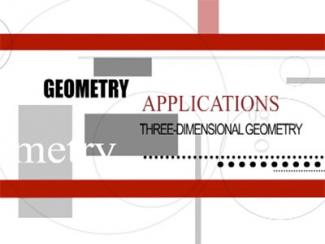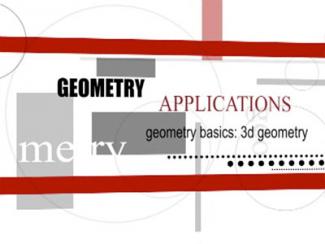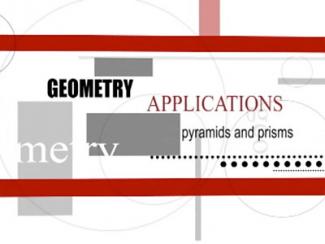
Illustrative Math Alignment: Grade 6 Unit 1
Reasoning to Find Area
Lesson 19: Designing a Tent
Use the following Media4Math resources with this Illustrative Math lesson.
| Thumbnail Image | Title | Body | Curriculum Nodes |
|---|---|---|---|

|
Video Transcript: Geometry Applications: 3D Geometry |
Video Transcript: Geometry Applications: 3D Geometry
This is the transcript for the video of same title. Video contents: In this program we explore the properties of three-dimensional figures. We do this in the context of two real-world applications. In the first, we look at the three-dimensional structure of Mayan pyramids. These stair-step structures provide a unique opportunity to also explore sequences and series. In the second application we look at the Shanghai Tower as an example of cylindrically shaped structures. |
3-Dimensional Figures and Applications of 3D Geometry |

|
Video Transcript: Geometry Applications: 3D Geometry, Segment 1: Introduction |
Video Transcript: Geometry Applications: 3D Geometry, Segment 1: Introduction
This is the transcript for the video of same title. Video contents: We visit ancient Greece to learn about the Platonic Solids. This provides an introduction to the more general topic of three-dimensional figures. This is part of a collection of video transcript from the Geometry Applications video series. To see the complete collection of transcripts, click on this link. Note: The download is a PDF file. Video Transcript LibraryTo see the complete collection of video transcriptsy, click on this link. |
3-Dimensional Figures and Applications of 3D Geometry |

|
Video Transcript: Geometry Applications: 3D Geometry, Segment 2: Pyramids |
Video Transcript: Geometry Applications: 3D Geometry, Segment 2: Pyramids
This is the transcript for the video of same title. Video contents: Rectangular Prisms. Mayan pyramids are essentially stacks of rectangular prisms. The volume of each successive level is a percentage decrease of its lower neighbor. This introduces the notion of a geometric sequence and series, including an infinite series. |
3-Dimensional Figures and Applications of 3D Geometry |

|
Video Transcript: Geometry Applications: 3D Geometry, Segment 3: Cylinders |
Video Transcript: Geometry Applications: 3D Geometry, Segment 3: Cylinders
This is the transcript for the video of same title. Video contents: The Shanghai Tower in China is a stack of cylindrical shapes, where each successive layer is a percentage decrease of its lower neighbor. As with the previous section, this introduces the notion of a geometric sequence and series. |
3-Dimensional Figures and Applications of 3D Geometry |

|
VIDEO: Geometry Applications: 3D Geometry |
VIDEO: Geometry Applications: 3D Geometry
Topic3D Geometry |
3-Dimensional Figures and Applications of 3D Geometry |

|
VIDEO: Geometry Applications: 3D Geometry, 1 |
VIDEO: Geometry Applications: 3D Geometry, 1
Topic3D Geometry DescriptionThis segment introduces Platonic solids, including tetrahedron, cube, and dodecahedron, emphasizing their congruent edges, vertices, and angles. It connects these geometric figures to both natural and man-made structures, setting the stage for exploring 3D geometry applications. This video offers a comprehensive look at the mathematical concepts behind 3D Geometry. Students will gain insights into practical applications and theoretical understanding of the topic, enhancing their ability to visualize and apply these concepts. |
3-Dimensional Figures and Applications of 3D Geometry |

|
VIDEO: Geometry Applications: 3D Geometry, 2 |
VIDEO: Geometry Applications: 3D Geometry, 2
Topic3D Geometry DescriptionThis segment explores pyramids, particularly Mayan and Egyptian structures, to distinguish rectangular and square bases. It discusses the volume of truncated pyramids using proportional relationships and introduces the concept of tiered volume reduction through geometric sequences. This video offers a comprehensive look at the mathematical concepts behind 3D Geometry. Students will gain insights into practical applications and theoretical understanding of the topic, enhancing their ability to visualize and apply these concepts. |
3-Dimensional Figures, Pyramids and Applications of 3D Geometry |

|
VIDEO: Geometry Applications: 3D Geometry, 3 |
VIDEO: Geometry Applications: 3D Geometry, 3
Topic3D Geometry DescriptionThis segment examines cylinders, using the Shanghai Tower as a case study. It highlights how adjustments to height and radius affect volume and surface area, demonstrating these principles with geometric calculations and their architectural applications in energy efficiency. This video offers a comprehensive look at the mathematical concepts behind 3D Geometry. Students will gain insights into practical applications and theoretical understanding of the topic, enhancing their ability to visualize and apply these concepts. |
3-Dimensional Figures, Cylinders and Applications of 3D Geometry |